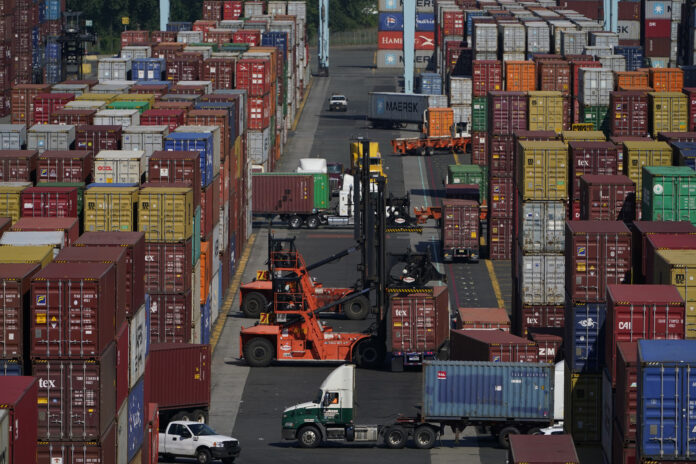|
Getting your Trinity Audio player ready...
|
Tens of thousands of dock and maritime workers could hit the picket lines on Oct. 1, the largest union of maritime workers in North America confirmed in a Sept. 30 statement.
The International Longeshoremen’s Association (ILA) posted on social media that many of the union’s members will strike at 12:01 a.m. on Oct. 1, when the current collective-bargaining agreement expires.
Union officials say they plan to hit the picket lines at three dozen facilities spread across all Atlantic and Gulf Coast ports from Maine to Texas, which handle 49 percent of U.S. container volume.
“The ocean carriers represented by USMX [United States Maritime Alliance] want to enjoy rich billion-dollar profits that they are making in 2024, while they offer ILA longshore workers an unacceptable wage package that we reject,” the ILA said. “ILA longshore workers deserve to be compensated for the important work they do keeping American commerce moving and growing.”
According to an official ILA press release, the union’s key demands include wage increases, better health care and retirement benefits, protections against automation, and all funds earned through the industry’s Container Royalty.
Of the 85,000 members, there are approximately 50,000 workers who are covered by the Master Contract, meaning they could walk off the job at midnight.
ILA officials accuse the USMX, a nonprofit association representing East and Gulf Coast longshore industry employers, of failing to address “a half-century of wage subjugation where ocean carriers profits skyrocketed from millions to mega-billion dollars, while ILA longshore wages remained flat.”
Last week, the USMX filed a complaint with the National Labor Relations Board requesting the ILA resume bargaining and negotiating a deal. The USMX accused the ILA of repeatedly refusing “to come to the table and bargain on a new Master Contract.”
If a strike goes ahead, it will be the first East and Gulf Coast strike since 1977. That year’s work stoppage lasted for 45 days.
President Joe Biden told reporters in Delaware over the weekend that he will not intervene in the matter.
The White House could tap the 1947 Taft-Hartley Act that permits the president to file a court order for an 80-day cooling-off period. This would suspend a strike and force both parties to return to the negotiating table.
The Transportation Trades Department (TTD) of the AFL-CIO shot back at calls for the administration to rely on the Taft-Hartley measure, saying that it “is not a winning strategy and should not be USMX’s expected path to resolution.”
Various East and Gulf Coast ports have outlined their contingency plans in the event of a strike.
‘Worst Possible Time’
“This is the worst possible time for a port strike since it will potentially affect the Christmas shopping season,” stated Stamatis Tsantani, the CEO and chairman of Seanergy Maritime and United Maritime, in an email sent to The Epoch Times.
The possibility of disruptions has forced freight rail operators, trucking companies, and retailers to scramble to move billions of dollars in trade to prevent shortages or delays ahead of the busy holiday shopping season.
These ports manage various imports, such as alcohol, apparel, automobiles and parts, food, and household furnishings and goods. Home Depot, Ikea, LG Electronics, and Walmart are some of the biggest corporations that import products into the East Coast ports.
A work disruption could also halt U.S. exports, impacting domestic companies.
Earlier this month, a coalition of more than 150 businesses and trade organizations penned a letter to the White House, urging action to prevent supply-chain disruptions and delays.
“Based on reports, a strike of any length of time is projected to cost at least a billion dollars a day and will have devastating consequences on the U.S. economy, consumer product companies, and American consumers,” said Ed Desmond, executive vice president of global government and regulatory affairs at The Toy Association, in the Sept. 17 letter.
When a port shuts down, the closure does not trigger an immediate impact “but a ripple effect until things normalize,” explains Tsantani.
“A port shutdown creates a backlog of ships, and the backlog of ships takes it then a longer to reach its next destination, and this has a cascade effect for all future destinations,” Tsantani said. “So that impact doesn’t happen immediately, but you feel the impact down the line months after.”
Even a one-week disruption could force a sizable backlog.
According to Seko Logistics, a strike could result in “severe congestion and halted operations” at major ports.
“For each day the ports are shut down, it is estimated that it would take nearly a week of recovery,” the company said in a report. “Warehouses and transportation hubs would face delays but may be manageable short term. Trucking and rail transportation would be heavily impacted and would lead to higher costs and longer delays.”
In response to any work stoppage, some firms have re-routed cargo to West Coast ports and added trucks and trains to ensure the imports arrive on time.
The East Coast’s share of total U.S. container imports from the Far East tumbled from 34.4 percent in the fourth quarter of 2023 to 32.6 percent in the second quarter of 2024. By comparison, West Coast ports’ share climbed from 55.5 percent to nearly 58 percent in the same span.
Despite the latest numbers, Fitch Ratings analysts do not anticipate a prolonged strike or a long-term shift in cargo to West Coast ports. They do, however, anticipate higher labor costs, which will be passed along in the form of “higher costs to shippers via rate increases where possible.”
While companies brace for a potential strike at midnight, market watchers are determining how a port strike could impact the broader economy.
Any ILA strike could “rock the boat as the delicate economy streams ahead,” says Mark Malek, the CIO at brokerage firm Siebert.
“Rational companies will not bear sustained supply inflation for too long and will eventually pass those cost increases on to consumers,” Malke said in a note, which via email was viewed by The Epoch Times. “Cost increases that will find their way into retail prices include shipping costs.”
Estimates vary on how much it could affect the U.S. economy, but a strike could cause a significant dent.
Oxford Economics, for example, estimates that the impending strike could reduce GDP by between $4.5 billion and $7.5 billion “for every week that it continues.”
“That hit would be reversed once the strike is over, but we estimate that for each week the strike continues, it would take a month to clear the backlog, partly because West Coast ports are already approaching capacity,” the group said in a research report.
And although the public might conjure up images of the pandemic-era supply chain snafus that contributed to 40-year high inflation, economists do not believe there will be a similar event.
Luke Tilley, the chief economist at Wilmington Trust Investment Advisors, told The Epoch Times at an American Bankers Association online event that a port strike is not seen “as a major inflation risk or a major supply-chain risk.”
“It’s more of like a disruptive to spending and a little bit to pricing, but not like to ongoing inflation or an ongoing supply-chain issue,” Tilley said, adding that the longer it goes on, the more troublesome it can be.
“But, certainly, something to watch to see how disruptive it is of economic activity,” Tilley stated.




